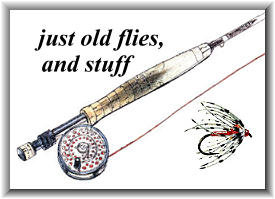In Fishing Atlantic Salmon author Joseph D. Bates, Jr.,
claims this dry fly for salmon, "is one of my favorites because it is
showy, unusual, hard to sink, and very productive. The Brown Bomber
calls for natural brown hair for tail and body, white wing (for better
visibility), and reddish brown ribbing. The White Bomber (sometimes
called the Peppermint bomber) is all white with red ribing. The
Black Bomber is all black with white ribbing.
The Bomber dry flies should not be confused with wet-fly patterns
of the same name. Bombers were developed in the 1960's for use
on New Brunswick's Miramichi River and popularized by the Revernend Elmer
Smith, a great authority on salmon and a legendary figure on the Miramichi.
Inspired by the success he observed as a young boy having with a spun-hair
mouse, Father Smith tied his first Bomber as a wet fly, trimming its
bulky body and using a single grizzly hackle, dyed red, tied in at the bend
and palmered forward over the body. Later, thinking the fly would be effective
as a dry fly, he dressed it in several variations, preferring a body of
spun deer hair, trimmed and tapered toward the eye, with two stiff hackles
tied in by their butts and wound forward.
Some anglers say that if you can't catch a salmon with a Bomber, you
shouldn't bother fishing. Bombers can be fished dry (the usual
practice), dry and dragging (with a fast skittering motion), or wet (like
any other sunken fly). They are effective in each technique."
Bomber
As dressed by Warren Duncan
Tail: A fairly large and rather short bunch of the same
deer body hair used for the body of the fly. (Other
materials are often used, such as calf or woodchuck.)
Wing: A fairly short bunch of the same body hair
tied so as to extend forward at an angle of about 45 degrees.
(This forward and upward bunch of hair is called a "wing" for want
of a better term. The upward slant keeps it free of the eye of the
hook.)
Body: Natural deer body hair (gray, brown, or white) spun
on, tightly massed, flared out, and clipped to a smooth cigar shape,
tapering toward the tail and slightly toward the head. The body should
be clipped so that about one-third is below the hook shank and
two-thirds above it, to allow plenty of clearance between body and
barb. To produce a dense body, rather small bunches of body hair
should be used. Many anglers like the body rather roughly clipped.
Ribbing: (For the White Bomber shown): Grizzly hackle dyed red,
tied in at the tail and palmered through the clipped body from tail to head.
Head: Use any appropriately colored thread.

Credits: Information and photos from Fishing Atlantic Salmon,
by Joseph D. Bates, Jr, published by
Stackpole Books.
|



